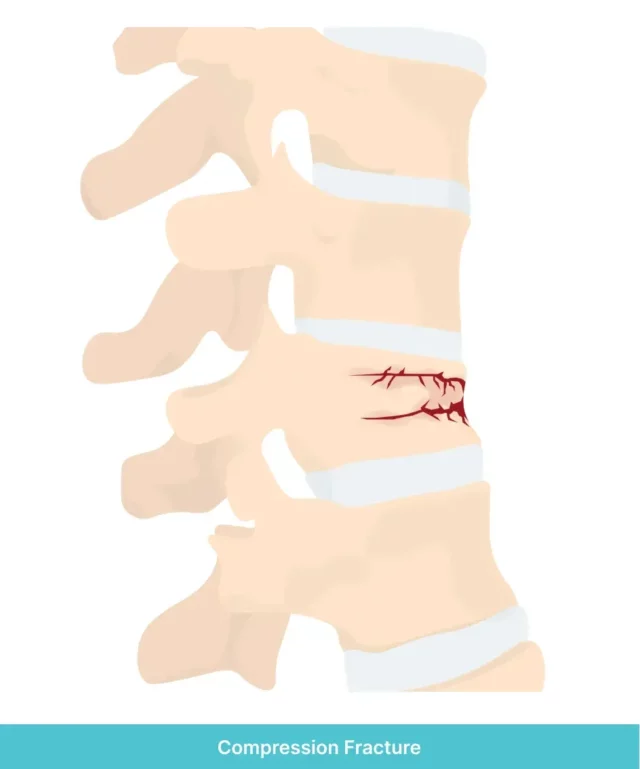Experiencing a bone fracture is undeniably a defining and challenging time. It causes immediate pain, which might persist for weeks or even months during the healing process. Fractures also limit your mobility and ability to carry out daily activities. Beyond the physical discomfort, they can become a predominant source of concern, affecting your emotional and mental well-being.
Whether the fracture was caused by a sudden accident, injury, overuse, or an underlying health issue, having an in-depth understanding is essential for effectively managing discomfort and optimizing recovery.
This article aims to provide valuable insights into all the nuances of bone fractures. We’ll explore the various types and causes, highlighting the symptoms and potential complications. We’ll also discuss the clinical process of assessing a bone fracture and the various treatment options available.
Additionally, we’ll explore how the healing process from a bone fracture can be both effective and more comfortable, thanks to the treatments offered by NextPain Care. Our approach is designed to alleviate pain and inflammation associated with a broken bone.
Let’s begin by learning more about the many types of bone fractures.
What Is a Bone Fracture?
A bone fracture occurs when a bone is damaged or broken. It usually leads to a sudden and potentially ongoing disturbance of its normal structure and function until it is treated and healed. The immediate consequence is pain, and a fracture can range from a very small hairline crack to a complete break.
There are many other types of bone fractures, each one bringing its own set of challenges.
Different Types Of Fractures
It’s important to recognize that not all bone fractures are the same and that their nature and severity will determine the course of treatment and overall recovery. Let’s explore the different types of bone fractures below.
Closed
A closed fracture, also known as a “simple” fracture, occurs when the bone is damaged, yet there’s no penetration through the skin. The good news is that this type of fracture is generally less complicated to treat. However, it still requires careful management to ensure the bone realigns properly during the healing process.
Open or Compound
On the other hand, an open or “compound” fracture occurs when the bone breaks through the skin, becoming visible. Due to the nature of this kind of fracture, there is an increased chance of infection and tissue damage. Immediate and specialized care is crucial for open fractures to ensure proper treatment and minimize potential complications.
Incomplete
An incomplete, or “partial” fracture, develops when the bone is partially broken but not completely separated. This subset also includes greenstick fractures in children, where the bone bends but doesn’t break entirely.
While the nature of these fractures may seem less severe, they require a highly involved treatment plan to ensure the bone heals in alignment and without deformity.
Complete
A complete fracture indicates a total break through the bone, resulting in two or more distinct pieces. When a complete fracture becomes “displaced,” it means the broken bone has moved out of proper alignment.
Beyond these broad categories, fractures are also named based on the pattern of the break, how the break looks, and what direction it’s broken, such as:
Transverse
Longitudinal
Alternatively, a longitudinal fracture is a break that runs parallel to the bone’s axis. While they’re less common in general, they are typically seen in long bone fractures, such as the femur.
Comminuted
Comminuted fractures are much more complex, involving the bone breaking into multiple fragments. This poses a much higher risk of complications during healing, and in many cases, surgical intervention is needed to restore stability and function.
Oblique
An oblique fracture is differently patterned again, describing a diagonal break across the bone. This type of fracture is often caused by a twisting or angular force.
Compression
Finally, compression fractures are frequently seen in the spine, where the vertebrae are crushed or collapsed. This can be caused by injury or osteoporosis but is usually due to age-related degeneration. This condition usually leads to a forward-leaning “stooped” posture in older adults.
While an open fracture and some complete fractures may be unmistakable, it’s not always so clear whether a bone has been broken. Let’s move on to how individuals can identify bone pain and the typical symptoms of fractures.

Recognizing A Fracture And Identifying Bone Pain
Pain is a very personal and subjective experience. This means that different people will experience varying levels of pain from bone fractures, and no particular type is inherently more painful than another.
In addition to this, bone pain can generate symptoms that are similar to other musculoskeletal conditions, like a sprained ankle, plantar fasciitis, or tendonitis, making them difficult to detect. Pain can feel like a deep ache, sharp pains, extreme tenderness, or pinching.
Aside from pain, there are additional symptoms that serve as telltale signs you may have fractured a bone. These include:
Swelling, Redness, or Bleeding
Bone fractures can cause symptoms of swelling and redness. This is a sign of the natural healing process, inflammation – the body’s initial response to injury. After the incident, the immune system immediately sends cells to remove damaged tissue, bone fragments, and blood from broken vessels.
The inflammation process then attracts more immune cells, increasing blood flow to the area. This is what causes the injured area to appear inflamed, red, swollen, and tender. In severe cases of open or compound fractures, there can be external bleeding.
Restricted Mobility
Experiencing restricted mobility and reduced function is a notable symptom of a bone fracture. Difficulty moving a limb or joint can be due to the break itself, tissue damage, pain, and swelling.
However, some people are able to keep moving a fractured bone, but just because there is mobility of the affected area doesn’t mean there is no fracture.
Broken Skin With Protruding Bone
Crepitus of Bone Fragments
Bone crepitus describes the grating or cracking sensation during movement that can accompany fractures. Recognizing this specific symptom as a potential bone fracture can guide individuals to seek an accurate diagnosis and targeted treatment.
We encourage you to listen to your body’s signals. If you experience bone pain or other signs that something isn’t right, it’s your body urging you to stop and seek medical attention. Quick recognition and timely intervention are key to preventing further damage and guiding an effective treatment strategy.
Joint Pain And Swelling
Joint pain is undeniably prevalent across all adult age groups and ranks among the most common musculoskeletal issues. However, its ubiquity does not diminish its impact; joint pain and swelling can severely restrict mobility, causing stiffness, throbbing...
Feeling of Pins and Needles
This “pins and needles” sensation occurs when certain nerves are pressured and are unable to send signals to the brain relating to movement or sensation. Some forms of paresthesia are temporary and benign and can be resolved by shifting your body’s...
Muscle Tenderness
Have you recently noticed muscle tenderness? You might be feeling tension and discomfort in areas like your neck, shoulders, lower back, hips, or legs. While mild discomfort may not be too bothersome, worsening symptoms can begin to affect your daily...
Common Causes Of Bone Fractures
Bone fractures can happen to anyone at any time. Although accidents and sports injuries are typical causes, fractures can occur for a range of reasons. Let’s look at some of the more common ones below:
Trauma or Injury
Accidents happen to all of us. Falls, sports-related impacts, or vehicular accidents all have the potential to cause fractures. If you’ve experienced any trauma or injury and have symptoms of pain or other signs that you may have broken a bone, it’s vital to seek prompt medical attention.
Overuse or Repetitive Forces
When repetitive force is placed on the bones, it can result in small fractures on the bone’s surface, described as stress fractures. People who engage in physical activities, such as athletes or individuals with physically demanding jobs, are more susceptible. These fractures are known to be quite painful and also contribute to a reduction in structural integrity.
Older individuals who begin exercising more regularly than in the past, either to stay fit or as part of a therapeutic regimen for a specific health concern, may also develop stress fractures.
Health Conditions
A number of medical conditions have the potential to weaken bones and raise the risk of bone fractures. These include, but are not limited to:
Osteoporosis
This condition is common in older individuals. It weakens bones by reducing bone density, making them thinner and more fragile. This is due to a reduction in new bone formation and makes them prone to fractures.
Bone Cancer
Bone cancer that originates in the bone itself, also known as a bone sarcoma, isn’t very common. It is more common to see cancers that have originated elsewhere and spread to the bones. Either way, developing cancer in the bone will seriously affect its integrity and is a serious risk factor for fractures. Maintaining bone strength and integrity during cancer treatment is crucial for overall health.
Hyperparathyroidism
Osteogenesis Imperfecta (OI)
This genetic disorder is aptly termed “brittle bone disease.” It is caused by a defect in the genes responsible for producing bone-strengthening collagen. As a result, bones develop with a weakened structure, making them fragile and prone to fracturing easily, even with little to no apparent injury.
Risk Factors Associated with Fractures
Understanding the factors that increase the likelihood of bone fractures can help you proactively improve your overall bone health. Let’s explore the following risk factors:
- Age: As we age, our bones tend to weaken naturally due to a reduction in new bone formation, making them more susceptible to fractures.
- Gender: Women, especially those who are postmenopausal, face an elevated risk of bone fractures because reduced estrogen levels can impact bone density.
- Reduced Bone Density: Reduced bone density, whether due to aging, medical conditions like osteoporosis, or lifestyle factors, weakens bones and increases the risk of fractures.
- Smoking: The use of tobacco directly affects bone health by causing reduced bone mass, increasing vulnerability to developing osteoporosis and fractures.
- Alcohol Consumption: Long-term alcohol consumption is known to weaken bones over time, making fractures more likely.
- Calcium and Vitamin D Deficiency: Adequate levels of vitamin D are vital for optimal calcium absorption in the body. Insufficient intake of these essential nutrients compromises bone strength and elevates the risk of fractures.
Being aware of these risk factors can help you make more informed choices about your lifestyle and recognize when to seek medical attention. Remember, your health is a priority, and there’s always support and guidance available for you.
Examinations to Identify Bone Fractures
When doctors suspect a bone fracture, they may order diagnostic tests to precisely identify and assess the bone and surrounding tissues. These tests provide health professionals with important information about the extent of the injury:
- X-Rays: X-rays are frequently used because they can provide clear and detailed images of the bones’ structure. A simple X-ray often suffices for your radiologist and doctor to decipher which bone is broken, where, and what type of fracture has occurred.
- Magnetic Resonance Imaging (MRI): An MRI is a powerful tool that offers detailed insights into soft tissues like muscles, ligaments, cartilage, and tendons. It is especially useful when symptoms might indicate soft tissue damage or if a severe fracture has potentially affected the surrounding structures.
- Computed Tomography (CT) Scan: CT scans are a special type of X-ray imaging that takes cross-sectional pictures, providing a 3D image rather than the X-ray’s 2D image. CT scans offer a comprehensive view of the injury from different angles, allowing specialists to evaluate both complex and small stress fractures and identify potential complications.
Why Do Fractures Require Immediate Medical Attention?
Seeking prompt medical attention and care for fractures is crucial, significantly influencing an individual’s overall recovery and well-being.
Early intervention ensures the fracture is accurately diagnosed and appropriately treated, improving the chances of successful healing. Without treatment, fractures can lead to complications such as misalignment, deformity, and stress on surrounding muscles and nerves. These issues may result in increased pain, reduced mobility, and long-term damage.
Moreover, delayed treatment of fractures can lead to complications that may require multiple surgeries. Even with surgical intervention, there is no guarantee that full mobility and function will be restored.
Beyond physical discomfort, the long-term effects of untreated fractures can impact a person’s mental health and overall quality of life. In the next section, we will discuss more about the acute and severe issues that may arise.
How Untreated Bone Fractures Can Lead To Serious Complications
Serious complications from untreated bone fractures can manifest within hours to days of the incident. This includes issues such as blood loss, ongoing damage to surrounding tissues and organs, and infections that may affect the bone or spread to the bloodstream, leading to sepsis.
Timely intervention for symptoms of a potential fracture is crucial to prevent these complications from escalating. Recognizing the urgency in treating fractures can prevent prolonged pain, potential disability, and the need for additional medical procedures.
A range of treatment options is available to manage the pain and discomfort of a bone fracture, support healing, and ensure a smoother recovery. Keep reading to learn more.
Conventional Treatment Options
The treatment choices for bone fractures will depend on individual factors like fracture severity, underlying health conditions, and personal preferences. To keep it simple, we’ll break down the different treatment options below:
Medication
Doctors often prescribe pain relievers and anti-inflammatories, such as ibuprofen, to manage pain and swelling during recovery. Over-the-counter options may not be sufficient in certain situations, and a doctor might suggest stronger prescription medications to keep you comfortable.
Immobilization
In many cases, keeping the injured bone still helps it re-align correctly, ensuring it regains strength and functions well once it has healed.
- Splint: A splint provides external support and prevents movement in the affected area.
- Brace: Braces are more rigid than splints and offer enhanced stability for fractures that require a more secure setting.
- Cast: Casts, made of plaster or fiberglass, provide comprehensive support. They aim to completely immobilize and stabilize the fractured bone during the healing process.
- Sling: Slings support and immobilize the arm, facilitating healing for certain upper body fractures.
Traction
Traction is a more involved treatment that typically requires hospital care. It involves the application of a gentle pulling force to realign and immobilize bones, which is particularly useful for fractures of the hips and lower legs.
Physical Therapy
Physical therapy is beneficial for minor fractures or as part of aftercare for larger fractures. It involves exercises and stretches that help restore mobility, strength, and flexibility. This provides additional and ongoing support after the initial healing phase.
Bone Surgery
Internal Fixation
Internal fixation surgery involves the use of implants such as screws, plates, or rods to stabilize fractures. These implants hold the broken pieces of bone in proper alignment, ensuring they heal correctly. This type of surgery is often used for severe fractures that cannot heal properly with just casting or bracing.
External Fixation
How Long It Takes To Recover From Fractures
The actual bone break is a singular event, but the recovery journey varies from person to person. The specific timeline depends on factors like the fracture’s severity and individual health conditions.
As a guide, minor fractures may mend in a few weeks, while complex ones could take months to a year. For a speedy recovery, it’s important to follow your doctor’s treatment plan and ensure your pain is well managed.
Effectively managing pain is a key component of healing. This is because the stress response to pain can hinder the recovery process. So, having effective pain control not only boosts your overall comfort but can also contribute to a more efficient recovery and improve your overall clinical outcome.
The NextPain Care Solutions For Bone Fractures
Mindfulness and Meditation for Chronic Pain
Mindfulness and meditation are techniques used to manage chronic pain by promoting relaxation and mental focus. NextPain Care incorporates these practices into its holistic approach to pain management, helping patients reduce pain perception and improve their...
Kyphoplasty
Kyphoplasty is a minimally invasive procedure used to treat spinal fractures. At NextPain Care, kyphoplasty is employed to stabilize the spine, relieve pain, and restore vertebral height. The procedure involves the insertion of a balloon into the fractured...
Vertebroplasty
Vertebroplasty is a minimally invasive procedure used to treat spinal fractures. At NextPain Care, this procedure involves injecting bone cement into the fractured vertebra to stabilize the spine and reduce pain. NextPain Care's vertebroplasty treatment aims...
"Treatment options are tailored to your individual needs, and availability may vary based on factors such as location and insurance. We’re here to guide you through the possibilities and help determine the best course of action for your journey to relief and recovery."
Begin Your Recovery with NextPain Care
Our Providers
We take great pride in the wealth of talent and expertise that our physicians and providers have as they improve the health outcomes of our patients, each and every day.





Rediscover your mobility and help restore bone functionality





